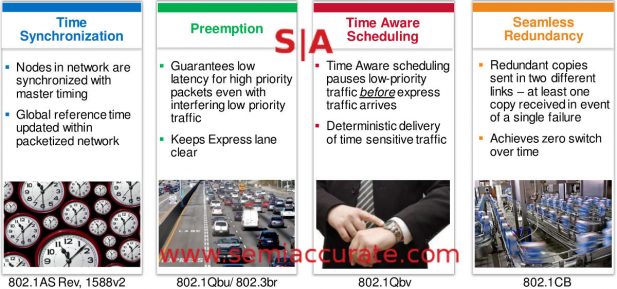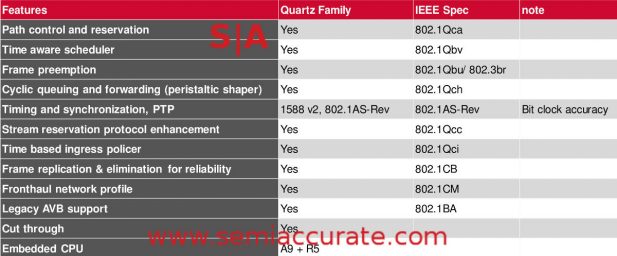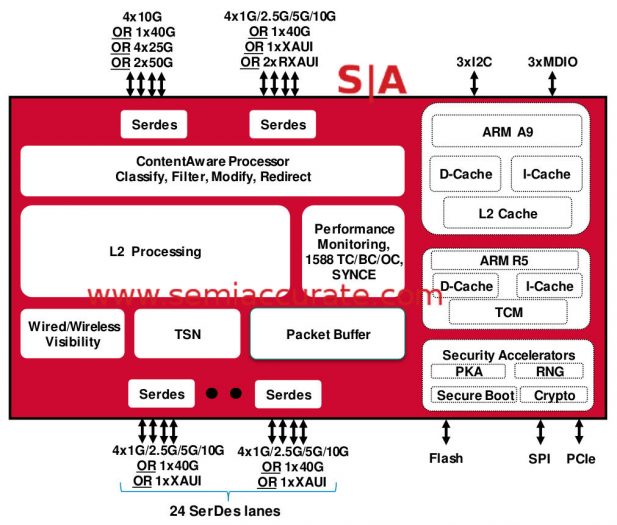![]() Today Broadcom is launching the first Time Sensitive Network (TSN) chip called Quartz. If you think you knew the OSI 7-layer stack before, SemiAccurate has some news for you.
Today Broadcom is launching the first Time Sensitive Network (TSN) chip called Quartz. If you think you knew the OSI 7-layer stack before, SemiAccurate has some news for you.
Broadcom is claiming Quartz aka BCM53575A0IFSBG and its little brother BCM53570A0IFSBG are the first full non-ASIC implementation of the Time Sensitive Network protocols. While you are probably familiar with 802.1AS Rev, 1588v2, 801.1Qbu, 802.3br, 802.1Qbv, and 802.1QB, lets refresh your memory in case you forgot a few details. We can do this with a handy chart that explains what TSN does.

Can you see where this is going?
What TSN does is to synchronize clocks on the network for frequency and phase very precisely. You can also have multiple synchronized domains but they can be in different epochs. The idea is to guarantee time of arrival of traffic very precisely with early being of no benefit, late being very bad, and on time being mama bear’s porridge. The four main categories above show the broad strokes of TSN, the specific protocols are a bit more complex.

For now you need this for TSN
If you are really familiar with the OSI stack, you will notice one thing, the above benefits are already implemented in the stack in one way or other. More or less. What TSN effectively does is to add four main advances to Ethernet. The first is TSN is now a guaranteed delivery, something Layer 2 was never intended to be. If you don’t have guarantees of delivery, it is kind of hard to have a guaranteed time of delivery. Current networks tend to do this at Layer 4 but if your application is at all latency sensitive, this retry will add intolerable time.
Second on the list is a deterministic schedule for arrival, something that is really hard to pull off. TSN uses preemption and an ‘Express Lane’ kept clear for this purpose. Add on cut through switching and you have a good foundation for determinism. Again this is something vanilla Ethernet just didn’t even attempt because it was never meant to.
All of this is nice for critical applications, not just time critical applications, but it can all fall apart with a single Layer 1 problem. That brings us to built-in redundancy, the third major change. While TSN doesn’t specify an exact topology for the redundancy mechanism, rings are the most often implemented methodology. If you have a better idea you can probably use it but just be aware that redundancy is ts at the heart of TSN because critical applications usually are actually critical.
Last up we have the obvious change of synchronous time across the network. Ethernet of old didn’t care about time because there was no need to. Asynch was just fine, if something collided or went boink on the wire, a higher layer protocol would fix the issue. Or not. With the guarantees of TSN this is not just unacceptable but requires extremely precise clocks. In theory this and the above protocols will ensure there are no collisions.
As you can see the benefits of TSN were more of less available in other ways from higher up in the OSI stack. All together TSN makes these higher level features unnecessary because Layer 2 now does the job. But why? To answer that Broadcom points to four major markets for TSN chips, automotive/self-driving cars, 5G base stations, industrial automation, and high rez professional A/V. Lets use self-driving cars to explain things, it is the easiest example.
Broadcom is targeting not the current or near future cars for TSN but next generation capabilities here. If you have a truly autonomous vehicle you will need lots of high rez cameras, compute, transport, I/O, and much more. When moving a multi-thousand pound chunk of metal at tens of MPH, safety is a concern. Getting a critical signal to the needed location is equally critical, as is time synchronization. Cameras being a frame or two off each other can have some interesting effects if you use optically based algorithms to compute distance for example. Then there is reliability, do we really need to go into why redundancy is a good thing here?
All of the above requirements can be met with traditional Ethernet protocols coupled with higher layers of the stack. They add latency and are a hack. With a TSN network instead of tuning retry algorithms and putting in delays to processing to make sure your data is there before you crunch numbers, you just send the data. If you assume the hardware will catch a physical fault and shut the system down, software can just fire and forget with data, the network effectively becomes a big UDP pipe that doesn’t hiccup.
Once you get this far you can further reduce latency by choosing simpler protocols, the hardware does the hard parts for you. The more you look at the benefits, the more they snowball into lower latencies and simpler code. Simpler code usually means less bugs but also can mean lower costs for OEMs too. In addition to the first order benefits, TSN has a lot of secondary values.

Block diagram of the new chip
At the hardware level, Quartz is a Broadcom StrataXGS switch SoC with some minor modifications. Yes that was sarcasm because all the higher level features of the XGS have been summarily ripped out and replaced with the TSN features. If TSN does in Layer 2 much of what the XGS does at Layers 3+, why keep that silicon in there? This may be an oversimplification but it gives you an idea of Quartz’s DNA, the L2 features should be pretty robust.
The two Quartz variants, BCM53575A0IFSBG and BCM53570A0IFSBG, are 10GbE and 1GbE members of the family. They both have 24 TSN Ethernet ports of their respective speeds and the big one adds 2x50GbE ports for uplinks, the smaller has 4x10GbE. Since both are based on StrataXGS, if you are familiar with the low-level details of that family, Quartz should not be a big leap for you.
Overall TSN brings higher level OSI stack features to L2 and does them in hardware without user intervention. This cuts out latency and adds reliability in a much simpler way, for the user anyway, and does it in a uniform fashion. In theory TSN Ethernet should be as simple as Ethernet with no proprietary stacks to integrate into your solution. On the down side TSN blows the age old OSI stack model out of the water, somewhat, but that is a pretty small price to pay for the benefits.S|A
Charlie Demerjian
Latest posts by Charlie Demerjian (see all)
- Qualcomm Is Cheating On Their Snapdragon X Elite/Pro Benchmarks - Apr 24, 2024
- What is Qualcomm’s Purwa/X Pro SoC? - Apr 19, 2024
- Intel Announces their NXE: 5000 High NA EUV Tool - Apr 18, 2024
- AMD outs MI300 plans… sort of - Apr 11, 2024
- Qualcomm is planning a lot of Nuvia/X-Elite announcements - Mar 25, 2024